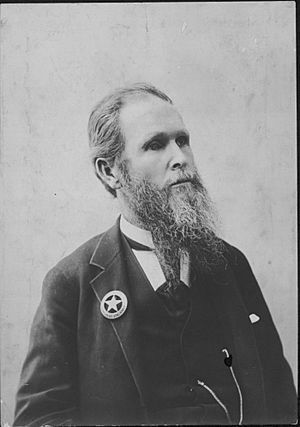Edward Griffin Hitchcock facts for kids
Edward Griffin Hitchcock (born January 20, 1837 – died October 9, 1898) was an important law enforcement officer in Hawaii. He was known by the nickname "Holy Terror." He served in the Kingdom of Hawaii and later became the Marshal of the Republic of Hawaii. This was the highest police position in the country.
Contents
Life and Career in Hawaii
Edward Griffin Hitchcock was born on January 20, 1837, in Lahaina, on the island of Maui. His father, Harvey Rexford Hitchcock, was an early missionary. Missionaries were people who traveled to new places to share their religious beliefs. His mother was Rebecca Howard.
Edward went to Punahou School from 1847 to 1853. On April 11, 1862, he married Mary Tenney Castle. Her father, Samuel Northrup Castle, was a founder of a big company called Castle & Cooke. Edward later managed his family's sugarcane farm, known as a plantation, in Pāpaʻikou.
Becoming a Sheriff
On April 5, 1888, Edward Hitchcock was appointed as the Sheriff for the island of Hawaiʻi. A sheriff is a chief law enforcement officer for a county or region.
In December 1889, a deputy sheriff told him about a sad event involving a Japanese immigrant named Katsu Goto in Honokaʻa. Hitchcock worked hard to find the people responsible. They were put on trial and found guilty. This event was later made into a play and a memorial was built for Katsu Goto.
Marshal of the Republic
In early 1893, the Kingdom of Hawaii was overthrown. This meant the government changed. The previous Marshal, Charles Burnett Wilson, was seen as loyal to the deposed Queen Liliʻuokalani. Edward Hitchcock then took his place as Marshal. This was the top law enforcement job in the country.
Because he was very good at finding suspects and had strong connections to the missionaries, people gave him the nickname "Holy Terror."
He lived in Honolulu, the capital city, while he was Marshal for the new government, first the Provisional Government of Hawaii and then the Republic of Hawaii.
Challenges as Marshal
One of the first big challenges he faced was called the Leper War. This was about people with Leprosy, a serious skin disease. Hitchcock ordered these individuals to move to a special, remote colony called Kalaupapa. Some people on the island of Kauaʻi had to be moved by force. The Kalaupapa Leper Colony was often seen more like a prison than a hospital. A leader of this uprising, named Koʻolau, was even featured in a short story by the famous writer Jack London.
In 1895, there was an organized armed revolt against the new government in the capital. This was called the 1895 Counter-Revolution in Hawaii. After some fighting, the President, Sanford B. Dole, declared martial law. This meant the military took control. Hitchcock eventually arrested the leaders of the revolt, including the former Queen.
Edward Hitchcock resigned from his Marshal position on August 1, 1895. His deputy, Arthur M. Brown, took over. Hitchcock then returned to his duties as a Sheriff on the island of Hawaiʻi. In October 1896, he was appointed as a circuit court judge for the same island.
Death and Family Legacy
Edward Griffin Hitchcock passed away on October 9, 1898, in the Kohala area of Hawaiʻi island.
He and his wife, Mary, had six children who grew up.
- Harvey Rexford Hitchcock was born in 1864. He married Hannah Julia Meyer and died in 1931. Their son, Harvey Rexford Hitchcock, Jr., was a famous college football player in 1913.
- Mary Rebecca Hitchcock was born in 1866. She married Frederick Galen Snow and lived until 1958.
- Harriet Castle Hitchcock was born in 1868 and died in 1933.
- Edward Northrup Hitchcock was born in 1870. He married Clara Louise Fasset and passed away in 1901.
- Eloise Tenney Hitchcock was born in 1873. She married Frank Tallant Smith and died in 1899 in San Francisco.
- Mabel Winchester Hitchcock was born in 1876. She married Bertrand Ferdidand Schoen and lived until 1963.
Edward also had a nephew, D. Howard Hitchcock, who became a well-known painter. He was part of the Volcano School, a group of artists who often painted the volcanoes of Hawaiʻi island.


